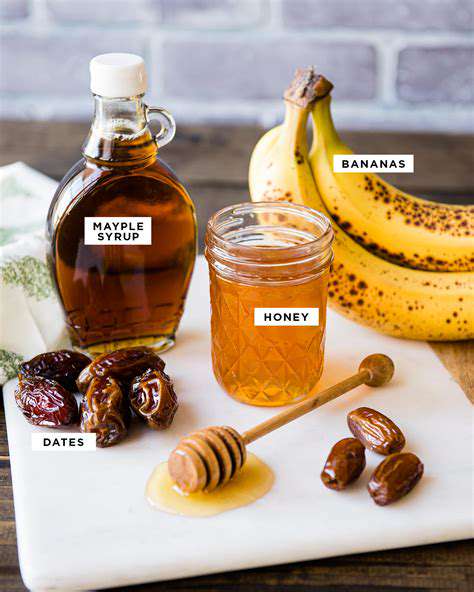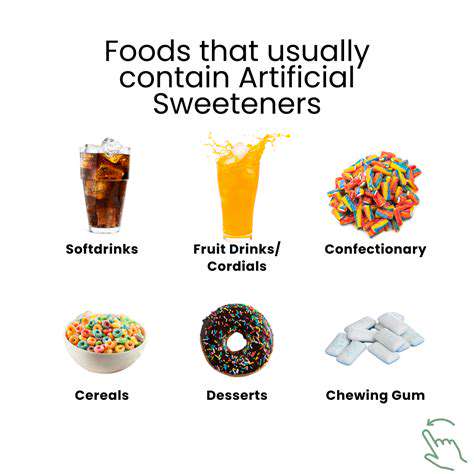Baking Without Sugar: Healthy Alternatives

Exploring the Sweetness of Maple Syrup
Maple syrup stands as one of North America's most cherished natural sweeteners, with a rich history dating back centuries. Its production involves a fascinating seasonal process where maple trees are tapped for their sap during early spring. The collected sap undergoes careful boiling to concentrate its natural sugars, resulting in the syrup's distinctive flavor. This traditional method preserves the syrup's unique characteristics while maintaining its natural properties. Many chefs and home cooks appreciate maple syrup for its ability to enhance both sweet and savory dishes.
The grading system for maple syrup provides helpful guidance for consumers. Lighter syrups generally offer more delicate flavors, while darker varieties provide more robust, caramel-like notes. Understanding these differences allows cooks to select the perfect syrup for their culinary creations. Regardless of grade, all pure maple syrup contains trace minerals that refined sugars lack.
The Delectable Delights of Honey
Honey presents another remarkable natural sweetening option with incredible diversity. Bees produce different honey varieties depending on the flowers they visit, resulting in unique flavors ranging from delicate and floral to rich and earthy. This natural variation means that honey can offer distinct flavor profiles to complement different dishes. Beyond its culinary uses, honey has played an important role in traditional medicine for centuries due to its potential health benefits.
The production of honey involves a complex natural process where bees transform flower nectar through enzymatic activity. This process creates honey's characteristic thickness and helps preserve it naturally. Many people appreciate honey not just as a sweetener but also for its potential antioxidant properties.
Comparing the Nutritional Profiles
While both maple syrup and honey serve as natural sweeteners, they differ in their nutritional composition. Maple syrup contains minerals like manganese and zinc, though in relatively small amounts. Honey typically offers more diverse nutrient content, including various antioxidants and enzymes. The specific nutritional value of each depends largely on factors like processing methods and floral sources.
Consumers should consider these differences when choosing between these sweeteners. Those seeking mineral content might prefer maple syrup, while individuals interested in potential antioxidant benefits might opt for honey. Ultimately, both options provide healthier alternatives to refined sugars when used in moderation.
Culinary Applications and Uses
Both sweeteners shine in the kitchen with their versatile applications. Maple syrup works beautifully in baking, as a pancake topping, or even as a glaze for meats. Honey's diverse flavor profiles make it suitable for everything from sweetening tea to creating complex marinades. The depth of flavor in maple syrup makes it particularly well-suited for balancing salty and savory ingredients.
Experimentation reveals the full potential of these natural sweeteners. Try drizzling different honey varieties over cheese plates or incorporating maple syrup into salad dressings. The possibilities for creative culinary applications are nearly endless.
The Health Implications of Natural Sweeteners
Current research continues to explore the potential health benefits of both honey and maple syrup. Some studies suggest they may offer advantages over refined sugar due to their additional nutrients and lower glycemic impact. However, it's crucial to remember that these are still concentrated sources of sugar and should be consumed in moderation. Individuals with specific health conditions should consult healthcare professionals about incorporating these sweeteners into their diets.
Balance remains key when using any sweetener. While natural options may offer some benefits, they still contribute to daily sugar intake and should be used thoughtfully as part of an overall healthy diet.
Dates and Applesauce: Moist and Delicious
Choosing the Right Apples
Selecting appropriate apple varieties forms the foundation of excellent homemade applesauce. Tart apples like Granny Smith contribute pleasant acidity, while sweeter varieties like Fuji provide natural sweetness. Combining different types allows for customized flavor profiles. The apple's texture also matters significantly - firm varieties maintain more structure during cooking, while softer apples break down more easily for smoother sauces.
Preparing the Apples for Baking
Proper preparation ensures optimal results when making applesauce. Begin by thoroughly washing apples to remove any surface residues. Coring is essential to eliminate bitter seeds and tough core material. Cutting apples into uniform pieces promotes even cooking, whether you prefer chunkier or smoother textures. For efficiency, consider using an apple corer or food processor, though hand-cutting allows for more control over piece size.
Controlling the Cooking Process
Gentle heat transforms apples into delicious sauce while preserving their natural flavors. Low simmering allows sugars to develop gradually without scorching. Stirring occasionally prevents sticking and ensures uniform texture development. Cooking times vary based on apple variety and desired consistency - test frequently for perfect doneness. Patience during this stage yields the best texture and flavor development.
The Importance of Liquid
Liquid plays several important roles in applesauce preparation. It prevents scorching, helps apples break down evenly, and allows for texture customization. Water works well for basic preparations, while apple juice intensifies flavor. The amount needed varies depending on apple moisture content and desired thickness. Start with small amounts and add gradually to achieve perfect consistency.
Balancing Sweetness with Applesauce
The natural sugars in apples often provide sufficient sweetness, especially when using sweeter varieties. For additional sweetness without refined sugar, consider options like maple syrup or honey. Spices like cinnamon can enhance perceived sweetness while adding depth. Taste testing during preparation helps achieve ideal balance. This approach allows for delicious results without excessive added sugars.
Adding Healthy Ingredients to Applesauce
Creative additions can transform basic applesauce into a nutrient-packed treat. Warm spices like nutmeg and cardamom add complexity without calories. Chopped nuts or seeds provide texture and healthy fats. For extra nutrition, consider blending in vegetables like pumpkin or sweet potato. These variations allow for personalized creations that suit individual tastes and dietary needs.
Serving Suggestions for Applesauce
Applesauce's versatility extends far beyond a simple side dish. Use it as a fat substitute in baking for moist, tender results. Layer it with yogurt and granola for a nutritious parfait. Serve alongside roasted meats as a tangy accompaniment. Frozen applesauce makes refreshing popsicles, while warmed versions comfort on chilly days. These diverse applications make applesauce a valuable staple in any kitchen.
Coconut Sugar and Brown Rice Syrup: Subtle Sweetness
Understanding the Substitutes
Exploring alternative sweeteners opens new possibilities for health-conscious bakers. Coconut sugar, with its caramel-like flavor, works particularly well in recipes benefiting from rich, deep notes. Brown rice syrup offers a more neutral sweetness that blends seamlessly into various preparations. Each sweetener behaves differently in recipes, requiring some experimentation. Understanding these differences helps achieve successful substitutions in traditional recipes.
Nutritional Comparisons
Coconut sugar retains some nutrients from the coconut palm, including minerals like iron and zinc. Brown rice syrup provides complex carbohydrates that digest more slowly than simple sugars. While neither qualifies as a health food, both offer advantages over refined white sugar. Comparing nutritional information helps determine which sweetener best suits individual dietary needs.
Flavor and Texture Differences
The distinct characteristics of these sweeteners influence final baked goods significantly. Coconut sugar's molasses-like flavor shines in gingerbread or chocolate recipes. Brown rice syrup's mild taste makes it versatile for recipes where other flavors should dominate. Both affect moisture content differently than white sugar, sometimes requiring recipe adjustments. Successful substitution depends on understanding these unique properties.
Baking Applications and Considerations
Each sweetener excels in specific baking applications. Coconut sugar works beautifully in cookies and quick breads where its flavor complements other ingredients. Brown rice syrup's binding properties make it excellent for granola bars and crispy treats. Successful use requires attention to how these sweeteners interact with other recipe components. Some trial and error helps determine optimal substitution ratios for different baked goods.
Tips for Successful Substitution
Transitioning to alternative sweeteners requires some practical adjustments. Begin by substituting small portions of sugar to observe effects on texture and flavor. Note that these sweeteners may brown faster than white sugar, requiring lower baking temperatures. Liquid content often needs adjustment to compensate for differences in moisture. Keeping detailed notes helps refine substitutions over time for consistent results.
Beyond Sweeteners: Flavor Boosters and Texture Enhancers

Beyond the Basics of Sweetness
Exceptional cooking involves balancing multiple flavor components beyond mere sweetness. Savory elements, acidity, and aromatic compounds all contribute to memorable dishes. Understanding how these components interact allows for more sophisticated flavor development. This holistic approach to flavor creates more satisfying and complex culinary experiences.
The Power of Umami
Umami represents one of the fundamental taste sensations that enhances overall flavor perception. Ingredients like mushrooms, tomatoes, and aged cheeses provide this savory depth. When used strategically, umami-rich components can reduce the need for excessive salt or sweeteners. Mastering umami incorporation elevates dishes from ordinary to extraordinary.
Enhancing with Acids
Acidic components provide necessary balance in many dishes. Citrus juices, vinegars, and fermented foods all offer varying degrees of tartness. These elements brighten flavors and cut through richness effectively. The right acid can make other flavors taste more vibrant and defined without overpowering them.
The Role of Spices and Herbs
Aromatic spices and fresh herbs contribute complexity beyond basic seasoning. They provide distinctive flavor notes that transform simple ingredients into special dishes. Understanding spice combinations allows for creative flavor pairings. Fresh herbs add brightness, while dried spices offer deeper, more concentrated flavors.
The Importance of Salt
Proper salting remains one of the most crucial yet often overlooked culinary skills. Salt doesn't just make food taste salty - it enhances and balances all other flavors. Learning to season food properly at different stages of cooking makes a dramatic difference. Thoughtful salt application can make other seasonings taste more pronounced.
Beyond Sweeteners: The Art of Contrast
Exciting flavor profiles often emerge from thoughtful contrasts. Pairing sweet with spicy or salty with sour creates dynamic taste experiences. These intentional juxtapositions keep dishes interesting and satisfying. Developing sensitivity to these balances helps create more memorable meals.
Texture as a Flavor Enhancer
Texture significantly influences how we perceive flavor and enjoy food. Crispy elements contrast beautifully with creamy components, while chewy textures provide satisfying mouthfeel. Thoughtful texture combinations can make simple dishes feel more sophisticated and satisfying. Paying attention to this often-overlooked aspect improves overall dining experiences.
- Healthy Meal Prep for Weight Loss: 5 Days of Deliciousness
- Exploring Italian Pasta Dishes: Beyond Spaghetti Bolognese
- Vegetarian Meal Prep Bowls: Easy and Nutritious
- Slow Cooker Comfort Food: Hearty Beef Stew Recipe
- High Protein Vegan Meals: Delicious Plant Based Power
- Pantry Staples for Healthy Eating: Must Have Ingredients
- Zero Waste Kitchen: Creative Ways to Use Food Scraps
- Baking with Alternative Flours: Gluten Free and Beyond
- Discovering Korean BBQ: Essential Marinades and Grilling Tips
- Crispy Air Fryer Chicken Wings: Game Day Perfection
- Cooking with Spices: A Beginner's Flavor Guide
- Mastering French Sauces: A Guide to Classic Techniques